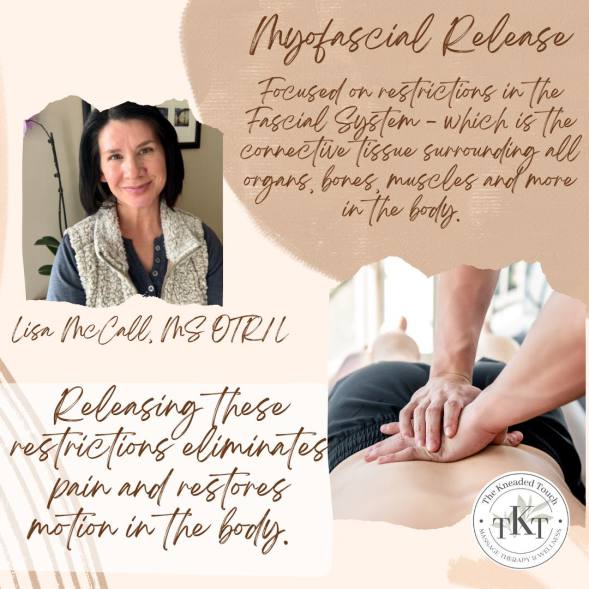Myofascial Release
by Lisa McCall, MS, OTR/L
We are happy to have Occupational Therapist, Lisa McCall on our team! She is highly trained in the John Barnes method of Myofascial Release & is excited to provide this type of bodywork to The Kneaded Touch!
The approach is different than the traditional massage therapy you are used to receiving at TKT. With an MFR session, time is spent at the beginning of the first session to go over pertinent past and current medical information. Clients receive a thorough postural analysis and evaluation that occurs in standing position and/or lying down on a massage table. Your MFR therapist is looking for asymmetries within the body.
MyoFascial Release
60 minutes - $135
*If this is your first session please book the MFR Session with Consultation so there is more time to do your assessment.
**Because of Lisa's Occupational Therapy License, a lot of her clients are able to submit their receipts from their sessions to their insurance and get reimbursed! Sometimes they get paritally reimbursed, and sometimes it is fully reimbursed. You are also more than welcome to use your HSA or FSA cards to pay for MFR or any Massage Therapy at TKT.
What is John F. Barnes Myofascial Release Therapy?
There are many different approaches to myofascial release therapy, but they all focus on releasing the fascia to reduce pain and increase mobility.
Traditional myofascial release therapy involves hands-on manipulation of the tissue using kneading massage motions and tools, which may cause more pain and inflammation
by creating additional cross-link tears in the fascia. The John Barnes approach considers the physics of how fluid moves in the fascial system, gently releasing that tension to encourage longer
lasting pain relief and improving movement.
When you are experiencing muscular pain, the fascial web is thick or tight, which inhibits movement. Myofascial release uses sustained but gentle pressure to release the
fascial restriction barrier. The therapist simply holds gentle tension on the area for five minutes or more, depending on the tightness of the fascia. The gentle pressure is no more than lightly
squeezing a balloon, or if you were to place your hand over a cold stick of butter and waiting for it to melt, thawing the freeze, and releasing the vice grip suffocating your body.
KIDS GET MFR TOO! (and they love it)
Kids are very receptive to John F. Barnes Myofascial Release because it is so gentle in nature. They have no expectation of the healing process and therefore allow it
freely. Plus, their connective tissues are naturally more fluid than compared to an adult.
Infants through youth are the ideal age to:
-correct structural imbalances (leg length discrepancies, pelvic tilt/rotation)
-headache
-Torticollis
-Scoliosis
-Orthopedic
-Head trauma
-Neurological
-Digestion and elimination
-Sports related injuries
What is Fascia?
It is not your skin that holds your body and organs together. It’s actually fascia! To generalize, fascia is a sheet of connective tissue that holds everything in your body together. It covers every internal part of the body, stabilizing movements, protecting against damage, and reducing friction in the joints. Have you ever peeled an orange and picked off all the “white stuff?” That “stuff” is what’s holding the shape of the entire orange, the single segments of the orange and even every itty bitty piece of pulp! This is fascia for fruit!
Fascia is:
-3D web that connects all parts of the body
-allows flexibility and motion
-gives support and stability
-acts as a shock absorber
When you experience a physical injury, accident, or actively perform repetitive movements, it causes a structural change to your fascia. When you experience an emotional
trauma and don’t allow your body to process those feelings over time, that emotion can become physical pain, changing the structure of your fascia.
The results of surgery, scarring, trauma or poor inflammatory responses can create fascial restrictions, leading to crushing pressure in pain-sensitive structures
throughout the body (LIKE A VICE OR CLAMP).
Injured Fascia:
-increased pain and discomfort
-increased inflammation
-decreased ROM and mobility
-inability to relax, sleep well and enjoy life
-increases faulty body mechanics that start to feel normal (but are not)
These injuries and restrictions to fascia aren’t visible with standard tests like x-rays and CT scans, so they often go overlooked or misdiagnosed. New technology allows
researchers to view the three-dimensional fibrous fascial web and the fluid within it using internal microscopes. Science is slowly catching up to understanding the importance of the fascia’s fluid
substance.

